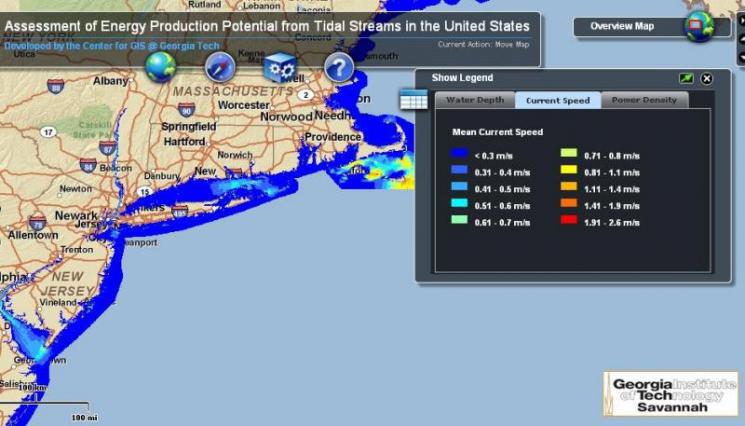Tapping into Wave and Tidal Ocean Power: 15% Water Power by 2030
January 27, 2012
 A map generated by Georgia Tech's tidal energy resource database shows mean current speed of tidal streams. The East Coast, as shown above, has strong tides that could be tapped to produce energy. | Photo courtesy of Georgia Institute of Technology
A map generated by Georgia Tech's tidal energy resource database shows mean current speed of tidal streams. The East Coast, as shown above, has strong tides that could be tapped to produce energy. | Photo courtesy of Georgia Institute of Technology In the most rigorous analyses undertaken to date, two recently released resource assessments show that waves and tidal currents off the nation's coasts contain enough energy to provide a significant portion our nation’s total annual electricity usage.
The United States uses about 4,000 terawatt hours (TWh) of electricity per year. The reports find that the nation’s waves and tides could potentially produce up to 1,420 TWh annually, or 15 percent of America’s electricity. Although these resources won’t be used in their entirety, they represent a major opportunity for America to harness homegrown, clean power and create jobs.
The West Coast, including Alaska and Hawaii, has especially high potential for wave energy development while significant opportunities also exist along the East Coast, which have strong tides that could be tapped to produce energy.
The assessments—Mapping and Assessment of the United States Ocean Wave Energy Resource and Assessment of Energy Production Potential from Tidal Streams in the United States—reflect the size and magnitude of waves and tides in the ocean and serve as a foundation for an ongoing effort to map out the best locations for extraction of ocean energy.
The Energy Department’s National Renewable Energy Laboratory incorporated the data from the wave resource assessment into its U.S. Renewable Resource atlas, where viewers can pan, zoom, and filter through graphically displayed data layers. In the future, 30 years of wave and weather data will be incorporated into the database to inform technological requirements and risks associated with wave energy development projects.
Georgia Tech‘s previously announced tidal streams database displays online maps that allow the public, policy makers, and water power developers to easily explore potential marine and hydrokinetic power-producing regions in the United States.
For more information about other water power resource assessments, visit the Energy Department’s Water Power Program website.
No comments:
Post a Comment
Note: Only a member of this blog may post a comment.